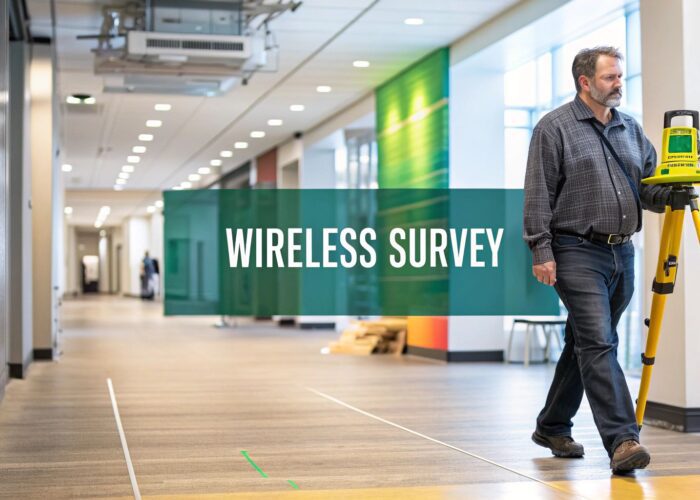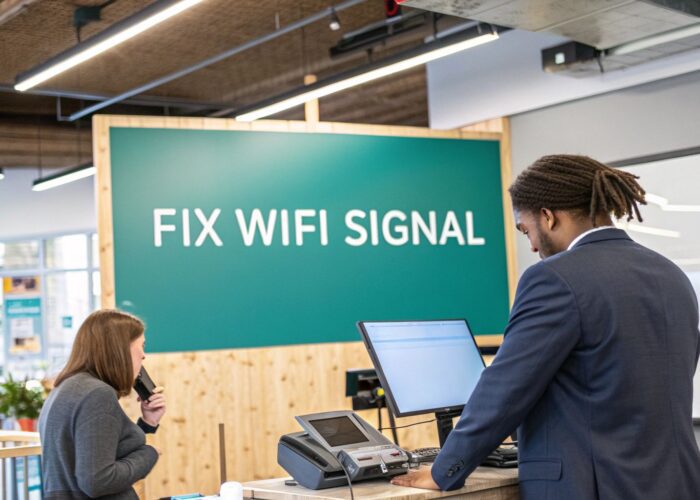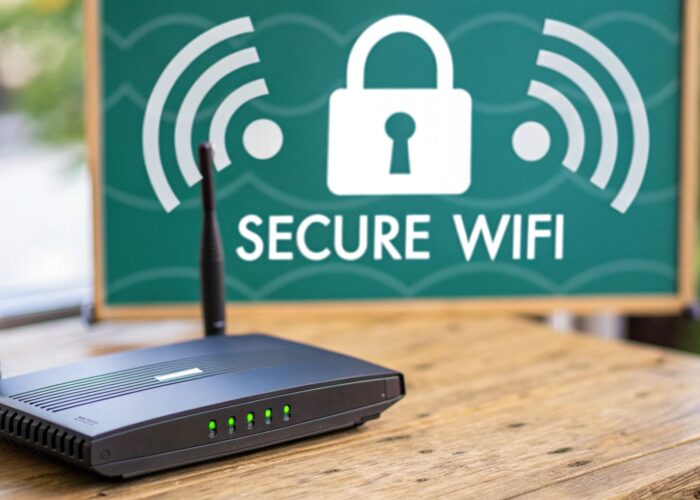Trying to run a marketing campaign without a solid measurement plan is like driving blind. You might be moving, but you have no idea if you're headed in the right direction. Hey, let's be real – effective measurement isn't just about proving ROI. It’s about getting inside your customers' heads, understanding their real-world behavior, and using that knowledge to justify your budget and make your next move smarter.
Why Measuring Your Marketing Is Non-Negotiable
Let's be real: marketing without data is just hoping for the best. In today's world, every single dollar needs to pull its weight. Measuring how well your campaigns are doing is absolutely essential for growth, especially in places like retail stores, university campuses in the education sector, and corporate offices with Bring-Your-Own-Device (BYOD) policies.
When you take a data-first approach, your marketing team can stop guessing and start making decisions based on what's actually happening.
This really gets to the heart of it: analytics should be your steering wheel, not just a rearview mirror.
Beyond Clicks and Impressions
Of course, traditional digital metrics like clicks and impressions have their place, but they rarely show you the full picture. What happens after the click? What if your online ad is designed to get people to walk into your physical store or show up at a campus event? That’s where the link between digital and physical often breaks.
This is exactly where technologies like Cisco Meraki's Captive Portals can be a total game-changer. They turn your guest Wi-Fi from a basic amenity into a seriously powerful data tool, bridging the gap between your online efforts and real-world actions. Suddenly, you have a direct way to see who's on-site and what marketing messages are actually resonating.
Connecting with Your Audience On-Site
The moment a customer connects to your Wi-Fi is a golden opportunity. A captive portal can instantly serve up a targeted ad, a special offer, or just a clean, secure login. This is incredibly valuable in different environments:
- Retail: A shopper connects to the Wi-Fi and immediately gets a digital coupon for the department they're standing in.
- Education: Students and campus visitors get quick, easy internet access, while the university can see which areas of the campus are busiest and when.
- Corporate BYOD: Secure login methods like IPSK and EasyPSK authentication solutions keep the network safe while still giving you a channel to measure internal communications.
The real power comes from turning a simple connection into a meaningful interaction. It's about gathering consent-based, first-party data that helps you understand who your customers are and what they respond to.
In the end, this is all about learning. Every campaign teaches you something that makes the next one better. If you want to dig deeper into the financial side, great guides on how to measure marketing ROI are available.
Choosing KPIs That Actually Matter
It’s easy to get lost in a sea of data when you're trying to figure out if a marketing campaign is actually working. The secret isn't tracking every single click and impression you can find. It's about zeroing in on the Key Performance Indicators (KPIs) that are directly tied to what you want to achieve.
What works for a busy retail shop won't be the same for a university campus in the education sector or a corporate office with a BYOD policy. You have to match your metrics to your mission.
Think about it this way: if you're a retailer aiming to increase foot traffic, who cares about your website's bounce rate? You need to know how many people physically walked through your doors after seeing your ads. For a university trying to boost engagement at campus events, the key metrics would be all about attendance and how long students stick around.
This is where your Wi-Fi network turns into a surprisingly powerful marketing tool. When you use a captive portal for guest access on a network powered by something like Cisco Meraki, you suddenly unlock a whole new world of real-world KPIs. It’s the bridge between your online campaigns and what people do in your physical space.
Connecting Your Goals to Wi-Fi Metrics
With Wi-Fi analytics, you can suddenly track things that used to be completely invisible. This gives you a much fuller picture of your marketing impact, going far beyond the usual online stats.
Here are a few examples of what you can measure:
- Login Counts: This is a fantastic proxy for foot traffic. How many people connected to your Wi-Fi today versus yesterday?
- Dwell Times: You can see how long visitors are staying in certain areas. Are they actually lingering by that new product display you promoted online? Now you can find out.
- Repeat Visitor Rates: This helps you spot your regulars and measure how well your loyalty campaigns are working.
- Authentication Data: Using secure methods like IPSK or EasyPSK, you can analyze usage patterns while giving everyone a safe, seamless connection.
Focusing on these on-site metrics tells the true story of your campaign. You're no longer just measuring clicks; you're measuring actual customer presence and behavior.
It’s no secret that marketing has gone digital. By 2024, digital marketing spend in the U.S. shot up by 12%, now making up around 69% of all ad spending. This massive investment makes it more critical than ever to connect those digital dollars to tangible, real-world results—which is exactly what Wi-Fi analytics helps you do.
Picking the Right KPIs for Your Industry
Choosing the right KPIs all comes down to your environment. The table below gives you a clear roadmap for matching your campaign goals to specific, measurable Wi-Fi analytics metrics across different sectors.
Matching Campaign Goals to Wi-Fi Analytics KPIs
| Campaign Goal | Relevant KPI | How to Measure with Wi-Fi Analytics |
|---|---|---|
| Increase Retail Foot Traffic | New vs. Returning Visitors | Track unique device MAC addresses logging into the Wi-Fi portal over time. |
| Boost In-Store Engagement | Dwell Time | Analyze how long users stay connected in specific zones (e.g., near a promotional display). |
| Drive Restaurant Loyalty | Visit Frequency | Measure how often a known customer (logged in via email/social) returns within a month. |
| Improve Campus Event Turnout | Peak Connection Times | Monitor the number of concurrent Wi-Fi users during the event's scheduled hours. |
| Optimize Office Space Usage | Zone-Specific Device Counts | See how many devices are connected in different areas (e.g., conference rooms vs. common areas). |
Ultimately, picking the right metrics is about making your data work for you, not the other way around.
For a corporate office, understanding network usage in a BYOD environment can help shape internal communications. In a retail setting, you can get incredibly granular with metrics like visit frequency and customer loyalty.
And no matter what you're tracking, you need to understand the bottom line. Learning how to calculate Return on Ad Spend (ROAS) is non-negotiable for any marketer who wants to prove that their campaigns are actually making money.
Using Captive Portals to Capture Real-World Insights
Your guest Wi-Fi network is so much more than a simple amenity. If you're only offering a password and a connection, you're sitting on a goldmine of marketing data. The key to unlocking all that potential is your captive portal—it’s the perfect tool for measuring how your marketing campaigns perform in the real world, right at your physical location.
Forget those generic, clunky login pages from a decade ago. A modern captive portal, especially when it’s part of a solid infrastructure like Cisco Meraki, becomes an interactive welcome mat for your visitors. It's their first digital interaction with you on-site, making it prime real estate to grab their attention.
This is your chance to show off your latest campaign offer, run a quick one-question poll for instant feedback, or ask for a social media follow in exchange for free internet. Every click, every login, every interaction becomes a valuable, measurable data point.
Secure Logins and Smart Marketing Go Hand-in-Hand
In busy places where personal devices are everywhere—think a corporate office with a BYOD policy or a sprawling university campus in the education sector—security and a smooth user experience are non-negotiable. This is where modern authentication solutions really shine, giving you a seamless login process that doesn't get in the way of gathering great data.
We’ve seen solutions like IPSK (Identity Pre-Shared Key) or EasyPSK work wonders in these environments. They simplify everything by giving each user or device a unique, secure key to get online. This keeps your network safe while still allowing you to collect consent-based demographic and behavioral information.
Let's look at how this plays out in different industries:
- Education: A university can roll out EasyPSK to give students and faculty effortless Wi-Fi access everywhere on campus. By looking at the connection data, administrators can see which libraries, cafes, or student centers are most popular, directly measuring the impact of campaigns designed to promote those facilities.
- Retail: A department store can use a simple social login on its captive portal. With the user's permission, this provides a glimpse into customer demographics, showing exactly which segments are responding to the latest in-store promotions.
- Corporate BYOD: An office can use IPSK to securely get employee and guest devices onto the network. This allows IT and marketing teams to track usage patterns, which can help gauge the adoption of a new internal app or measure the reach of a company-wide announcement.
The real magic here is getting direct, first-party data about who is engaging with your marketing while they are physically inside your space.
This kind of information is incredibly valuable. It’s not based on guesses or third-party cookies; it’s based on the actual behavior of people interacting with your brand on location. You can finally draw a straight line between a marketing campaign and the foot traffic it generates. If you want to get into the technical nitty-gritty, you can learn more about how a Wi-Fi captive portal can be tailored to meet your marketing objectives.
Ultimately, by transforming your Wi-Fi into an intelligent marketing channel with a Cisco network, you create a powerful feedback loop. You run a campaign, you measure the real-world response through your captive portal, and you use those insights to make your next move even smarter.
Bridging the Gap: Connecting Online Campaigns to Real-World Visits
For any marketer, the holy grail has always been proving that a great online campaign actually got people through the door. For the longest time, this was a massive blind spot in measuring campaign ROI. Thankfully, we can now finally connect the dots between a digital ad and a physical visit. This is where your on-site Wi-Fi, especially when it’s running on a smart network like Cisco Meraki, becomes your secret weapon.
Let’s paint a picture. Imagine you're a retailer running a targeted social media ad for a new spring collection. A potential customer sees it, loves what they see, and decides to pop into your store. The second they connect to your guest Wi-Fi, you’ve created a direct link. That connection, often made through a captive portal, is the handshake that attributes their in-store visit directly back to your digital marketing spend.
From a Click to a Physical Connection
This is where the real magic happens. It’s not about guessing if your online ads are working anymore; it’s about watching them deliver in real-time. You can even dial in the experience by customizing the captive portal to mirror specific campaigns.
- Campaign-Specific Promo Codes: Flash a unique discount code on the Wi-Fi login page that's tied directly to the ad they saw. When a customer uses that code at checkout, you've got irrefutable proof of conversion.
- Tailored Landing Pages: Running a few different promotions? No problem. The captive portal can show a landing page that reflects the specific ad that brought them in, making for a smooth, consistent customer journey.
- A Quick "Hello": Sometimes the easiest way is to just ask. A simple survey question on login like, "What brought you in today?" with your active campaigns listed as options can provide immediate, valuable feedback.
This isn't just a retail trick; the strategy works across all kinds of industries. A university promoting a campus career fair online can track Wi-Fi logins in the event hall to see exactly how many students showed up and which digital channels worked best. In a corporate office with a "bring your own device" policy, secure login authentication solutions like IPSK or EasyPSK can simplify access while still giving the company insights into which internal communications are driving employees to use on-site resources.
The real goal here is to transform an anonymous visitor into a known contact. By linking their digital footprint to their physical presence, you get a much clearer picture of your campaign’s true impact.
Social media is a massive piece of this puzzle. With forecasts showing nearly 64% of the world's population will be on social media by 2025, it’s a non-negotiable channel for driving foot traffic. Marketers consistently lean on platforms like Facebook and Instagram for their impressive ROI, and we know that user-generated content often pulls in way more engagement than a standard brand post.
Ultimately, tying your online campaigns to offline behavior closes the marketing loop. For any business serious about maximizing its impact, using tools for location-based marketing is how you turn a physical space into a responsive, data-rich environment. It’s how you make every single marketing dollar count.
Turning Your Data Into Smarter Campaigns
Collecting data is just the beginning. The real value comes when you use those insights to make better decisions for your next move. Measuring marketing campaign effectiveness isn't a one-and-done deal; it's a constant feedback loop where every campaign teaches you something for the next one.
Think of your Wi-Fi analytics and captive portal interactions as your strategic playbook. Digging into this data shows you exactly what hit the mark and what missed it entirely.
Analyzing Your On-Site Campaign Data
It's time to get your hands dirty with the numbers coming from your Cisco Meraki powered network. Your goal here is to draw a straight line from a specific marketing action to a real-world result.
For example, did that special offer you pushed on the captive portal get way more clicks than usual? Or did that email blast to students actually drive more of them into the campus coffee shop?
Here’s a simple way to break down your performance review:
- Check Your KPIs: Go back to the goals you set. If you wanted to boost foot traffic in your store, did you see a corresponding spike in new Wi-Fi logins while the campaign was running?
- Segment Your Audience: Don't just look at the overall numbers. See how different groups responded. In a corporate BYOD environment using IPSK or EasyPSK, you can see if a new policy announcement resonated more with the engineering team than it did with sales.
- Gauge Portal Engagement: Which messages on your captive portal got people to click? This is gold. It’s direct feedback on what grabs your audience's attention the second they connect.
This whole process boils down to asking the right questions. In an education setting, you might ask, "Did our 'Finals Week Stress-Buster' event promo on the Wi-Fi portal lead to students sticking around the library longer?"
For a retail business, the question might be, "Did that 10% off coupon we offered at login actually translate to higher sales that weekend?"
The goal isn't just to look back at what happened. It's to turn that historical data into predictive intelligence that helps you forecast what will work next time.
Optimizing Your Next Marketing Push
Once you start spotting these patterns, the next step is putting what you've learned into practice.
If a certain type of offer always gets great engagement, it's a no-brainer—make it a central piece of your next campaign. If you notice engagement plummets on Friday afternoons, maybe shift your messaging to earlier in the week.
This cycle of analyzing and then optimizing is what separates good marketing from great marketing. It ensures every dollar of your budget works a little harder than the last. The intelligent network infrastructure from a provider like Cisco doesn't just give you connectivity; it gives you the clarity to sharpen your strategy.
By folding these insights into your workflow, you create a system where each campaign becomes more targeted and more effective than the one before it. If you want to put this on autopilot, looking into marketing automation integration is a fantastic next step.
Got Questions? We've Got Answers
If you're still wondering how your Wi-Fi network can double as a marketing powerhouse, you're in the right place. Let's tackle some of the most common questions we get from people just like you.
How Can a Captive Portal Actually Help My Retail Store’s Marketing?
Think of a captive portal as your digital front door. When a customer connects to your free guest Wi-Fi, it's your first opportunity to make an impression. Instead of just giving them internet access, you can immediately present a special offer, highlight a new collection, or invite them to join your rewards program.
But it goes deeper than that. With their permission, you’re gathering valuable contact info for future email or SMS campaigns. By digging into the login data from your Cisco Meraki network, you can start tracking foot traffic patterns, identifying your most frequent visitors, and pinpointing your peak hours. This means you can finally see a direct line between a marketing push and an increase in people walking through your door.
What Exactly Is IPSK and Why Does It Matter for a Corporate BYOD Setup?
IPSK (Identity Pre-Shared Key) is a much smarter way to handle Wi-Fi security, especially when your team brings their own devices (BYOD). Instead of one password for everyone, IPSK gives each person or device its own unique key to get online. It’s a simple concept, offered through features like EasyPSK, that massively boosts security without creating headaches for your staff.
So, where does marketing fit in? For internal campaigns, this is incredibly insightful. Since you can see who is connected, you can track network usage by department. This lets you measure things like the adoption of a new internal software you're promoting or see if that all-hands email actually drove employees to the new benefits page on the intranet.
Can Wi-Fi Analytics Really Measure How Successful a Campus Event Was?
Yes, without a doubt. Using Wi-Fi analytics to gauge event success is one of its most powerful applications. Your campus Cisco network holds all the data you need to get a real, tangible headcount.
Just look at the number of unique devices that connected to the network in the specific event zone during that time frame. That gives you a hard number for attendance, far more accurate than a visual guess.
Pro Tip: You can also use the captive portal to send a quick post-event survey to everyone who attended, gathering immediate feedback while it’s still fresh in their minds.
By comparing the Wi-Fi traffic during the event to the normal daily baseline for that area, you can clearly show how big of a draw your event truly was.
Ready to unlock the marketing insights hidden in your guest Wi-Fi? Splash Access works hand-in-hand with Cisco Meraki to give you the data you need for smarter, more effective campaigns. Find out how we can help you better connect with your customers.






